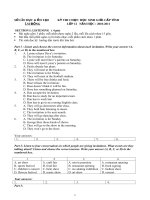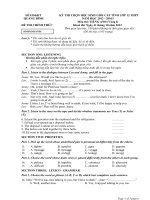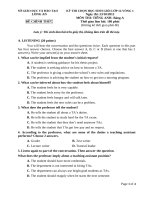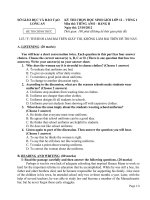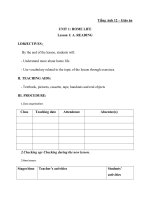Unit 12 water sports tiếng anh 12 giáo án hay
Bạn đang xem bản rút gọn của tài liệu. Xem và tải ngay bản đầy đủ của tài liệu tại đây (313.46 KB, 19 trang )
Giáo án Tiếng anh 12
Unit 12: Water Sports
Lesson 1: Reading
I. Objectives:
- Help students to practice reading skill basing on the context, guessing the meanings of words
and phrases.
- Read and answer questions about water sports.
- Read and fill the information.
II. Teaching aids:
- Text book
- Black board and chalk
- Pictures
III. Procedures:
Stage Teacher's activities Students' activities
Greeting
(1 m)
- Greet the students
- Ask students to settle down and prepare
for the lesson.
- Call the monitor and ask him about the
date and check the attendance.
- Stand up and greet the teacher.
- Sit down, keep silent and take out
their books, notebooks.
- The monitor stands up and answer
teacher’s questions
Checking
homework
( 5 ms)
* Check Ss' homework
- Call some Ss and ask them to bring their
notebooks to mark their homework.
- Some Ss hand in their notebooks to
the teacher.
- While teacher is marking their
notebooks, Ss keep silent.
Before
you read
(8 ms)
- Let the Ss work in groups of 4 to discuss
about the water sports.
- Give each group a picture and ask them
to discuss based on 5 questions:
1, Can you name the sport in the picture?
2, Where is it played?
3, How do people play it?
4, What type of the sport, team sports or
- Form their own groups by turning
back (two desks will form a group)
to discuss with each other about the
water sports.
- Get the picture and discuss 5
questions:
+ Group 1:
1, The sport in the picture is water
polo.
2, It is played in the water.
Giáo án Tiếng anh 12
individual sports?
5, What are the equipments?
- Walk around and help Ss of they have
difficulty in new words.
- After Ss finish discussing, call some
representatives of some groups to make a
report of what they have discussed.
- Give comments on what Ss report:
3, People play by hands.
4, It is a team sport.
5, Equipment is a ball.
While
you read
(25ms)
- Let Ss read the text and do the tasks
follow.
- While Ss are reading, teacher walks
around the class and observe Ss.
- After Ss finished reading, check the
tasks for Ss.
* TASK 1:
- Call 1 Ss to read out and translate the
instruction of task 1 into Vietnamese.
- Call Ss individually to do task 1
+ S1: Number 1
+ S2: Number 2
+ S3: Number 3
+ S4: Number 4
+ S5: Number 5
+ S6: Number 6
- Comment Ss' answers:
* TASK 2:
- Call 2 Ss to go to the black board and
write down their answers.
- While 2 Ss do the task on the black
board, ask the others to complete and
exchange their answers with their friends.
- Keep silent and read the text and then
do task 3 tasks at the same time.
- Concentrate on reading the text and do
the tasks.
- Complete reading and the tasks.
* TASK 1:
- 1 Ss reads out and translates the
instruction of task 1 into Vietnamese.
+ Task 1: Work in pairs. Match the
words in column A with their meanings
in column B.
- Ss individually stand up and do the
task.
+ S1: sprint: to swim very fast for a
short distance
+ S2: opponent: someone who tries to
defeat another person in a competition.
+ S3: penalize: to punish a team or
player who breaks the rules.
+ S4: eject: to make someone leave a
game.
+ S5: foul: an action in sports that is
against the rules.
+ S6: tie: a situation in a game when
two teams have the same scores.
* TASK 2:
- 2 Ss go to black board and do task 2:
1, Where can people play water polo?
People play it in a pool.
2, Where is the ball when the game
starts?
It is in the centre of the pool.
Giáo án Tiếng anh 12
- Give the comments:
* TASK 3:
- Ask Ss to read the passage again and do
task 3.
- Call 1 Ss to read out and translate the
instruction of task 3 into Vietnamese.
- Call 2 Ss to go to the black board and do
task 3.
- Ask Ss to compare their answers with
their partners.
- Check Ss' answers on the black board.
3, How can the ball be advanced?
The ball can be advanced by passing
with one hand or swimming with the
head above the water and the ball
between the arms so it rides on the
wave created by the swimmer's head.
4, Which players are allowed to hold
the ball with both hands?
Only the goalie can hold the ball
with both hands.
5, What happens to the player who
commits five personal fouls
The player is ejected after
committing five personal fouls.
6, How long does a game of water polo
usually last?
A game is divided into quarters
ranging from five to eight minutes in
length, depending on the level of play.
- Other Ss correct their answers in their
notebooks.
* TASK 3:
- Read the passage again and do task 3.
- 1 Ss reads out and translates the
instruction of task 3 into Vietnamese.
+ S11: Task 3: Complete the following
sentences using the information from
the passage.
- S12 and S13 go to black board and do
the task.
1, Water polo is played in a pool ____
meters deep, _____ long and _____
wide.
2, The home team wears _____, the
visiting team wears ______ and the
goalies wear______.
3, Both teams sprint fro the ball from
______.
4, A free throw is awarded for minor
fouls, such as ______.
Giáo án Tiếng anh 12
- Comment Ss' answers
5, A game is divided into quarters
ranging from _____ in length.
S1 S2
1, 1.8, 30 meters,
20 meters
1, 1.8, 30 meters,
20 meters
2, white caps, blue
caps, red caps
with the number 1
in white.
2, white caps, blue
caps, red caps
with the number 1
in white.
3, their own goal
lines
3, their own goal
lines
4, holding or
punching the
ball
4, holding or
punching the
ball
5, five to eight
minutes.
5, five to eight
minutes.
After
you read
(5 min.)
+Ask Ss work in groups of 4 to make a
comparison between football and water
polo, using the following suggestions:
• Places to play
• Number of players
• Main rules
• Length of time
- Call 2 Ss to make a comparison between
football and water polo
- Comment Ss' answers:
- Listen to the teacher's instructions and
get ready to discuss.
- Form their own groups by turning
back (two desks will form a group)
- Use the handouts.
Football Water polo
Places ground water
No of
players
11 players 7 players
Rules
Time 90 ms/ match 5-8 ms/
quarter
- 2 Ss to make a comparison between
football and water polo. One talks about
football and the other talk about water
polo.
Home-
Work
( 1 min)
+ Learn by heart all the new words and
make sentences with them.
+ Summarize the reading text
+ Prepare for speaking skill.
- Write down their homework in their
notebook.
Giáo án Tiếng anh 12
Period 74 Unit 12: Water Sports
Lesson 2: Speaking
I. Objectives:
- Speaking about water sports
- Giving opinion on water sports.
II. Teaching aids:
- Text book
- Black board and chalk
- Handouts
- Pictures
III. Procedures:
Stage Teacher's activities Students' activities
Giáo án Tiếng anh 12
Greeting
(1 m)
- Greet the students
- Ask students to settle down and prepare
for the lesson.
- Call the monitor and ask him about the
date and check the attendance.
- Stand up and greet the teacher.
- Sit down, keep silent and take out their
books, notebooks.
- The monitor stands up and answer teacher’s
questions:
Warm-up &
check old
lesson
(10ms)
- Let Ss to do the matching activity about
vocabulary
- Deliver the handouts.
- While Ss are doing, teacher must go
round and observe Ss.
- After Ss finish, ask 2 or 3 Ss to go to the
black board and write down their answers.
- While checking, ask other Ss to write the
correct answer in their handouts.
- Give comments on what Ss have done:
+ Good, thank you.
+ You did a good job, thank you.
+ You still have some mistakes, try more.
- Listen to the teacher
- Close all their books to get ready to play the
game.
- Get the handouts from the teacher.
- Do the matching
- 2 or 3 Ss to go to the black board and write
down their answers.
S1 S2 S3
1 - d 1 - d 1 - d
2 - h 2 - h 2 - h
3 - m 3 - n 3 - m
4 - a 4 - a 4 - i
5 - l 5 - l 5 - l
6 - p 6 - p 6 - p
7 - n 7 - m 7 - n
8 - e 8 - e 8 - e
9 - b 9 - b 9 - b
10 - o 10 - o 10 - o
11 - f 11 - f 11 - a
12 - g 12 - g 12 - g
13 - c 13 - c 13 - c
14 - i 14 - i 14 - f
15 - k 15 - k 15 - k
Giáo án Tiếng anh 12
Speaking
(33ms)
* Task 1:
- Ask Ss to work in pairs, look at the
picture and match the names with the
appropriate water sports.
- While Ss are talking, teacher must go
round and observe Ss. If they have
difficulty in vocabulary, help them.
- After Ss finish talking, teacher must
check Ss' answer by calling some pairs to
talk loudly.
* Task 2:
- Ask Ss to work in pairs and look at the
table and talk about each of the water
sports.
- Ask Ss to look at the example first.
- Call 1 student to read out the example.
+ Yes, thank you.
+ Are you clear?
+ Ok, let's start.
- Go around and urge Ss to speak.
* Task 3:
- Getting Ss to work in groups to discuss
the question:
+ Which of the above sports would you
prefer playing/ participating in?
- Explain why?
- Ask Ss to look at the example first.
+ So, now let's do the task.
- While Ss are talking, teacher must go
round and observe Ss. If they have
difficulty in vocabulary, help them.
* Task1:
- Work in pairs to match the names with the
appropriate water sports.
* Task 2:
- Work with their partner to talk about each
of the water sports.
- Look at the example.
- S1 stands up and reads out the example.
+ S1: Water polo is played in a pool. It is
played with a ball and people play it in a
team.
+ S2: Rowing is played in the sea, lake, or
river. It is played with a boat and oars and
people play it in a team or individually.
+ S3: Windsurfing is played in the sea, lake.
It is played with a board and sail. People
play it individually.
+ S4: Scuba-diving is played in the sea. It is
played with an air tank, regulator, wet suit,
mask, fins and people play it in a team or in
pairs.
* Task 3:
- Work in groups to discuss the question:
+ Which of the above sports would you
prefer playing/ participating in?
- Explain why?
- Look at the example first:
+ Example: I prefer scuba-diving to water
polo because it is adventurous. However, it
can be dangerous because you can easily be
attacked by sharks.
- Do the task.
Giáo án Tiếng anh 12
- Call some Ss to speak individually in
front of the class.
- Give comments on what Ss speak:
- Some Ss to speak individually in front of
the class.
Homework
(1m)
+ Do task 2 and task 3 in your notebooks
+ Prepare for the listening skill.
- Write down their homework in their
notebook.
Giáo án Tiếng anh 12
Period 75 Unit 12: Water Sports
Lesson 3: Listening
I. Objectives:
- Help students to practice listening skill by listening to the passage and fill in the blank with
information from the tape and answer the questions.
II. Teaching aids:
- Text book
- Black board and chalk
- Handouts
- Cassette and tape
III. Procedures:
Stage Teacher's activities Students' activities
Greetin
g
(1 m)
- Greet the students
- Ask students to settle down and prepare
for the lesson.
- Call the monitor and ask him about the
date and check the attendance.
- Stand up and greet the teacher.
- Sit down, keep silent and take out their
books, notebooks.
- The monitor stands up and answer
teacher’s questions:
Warm-up
& check
old lesson
(10ms)
- Get Ss to play a “BINGO” game.
- Tell Ss the rules of the game:
+ With a list of words, some of which
you have already learn, and the others
will appear in the tape while listening.
Each of you will get a card in which
there are 6 words and all these 6 words
are in my list. I’ll read out the words in
my list. If the words I read are in your
card, you have to cross them. When all 6
words in your card are crossed, you
have to stand up and shout “BINGO”.
The last person shouts “BINGO” will be
punished.
- Check Ss’ understanding of the rule.
- If Ss haven’t understood the rule,
teacher can translate it into Vietnamese.
- Ask Ss to start playing if they are ready.
- Deliver the cards
- Now we’ll start.
1, Water polo
2, vertical
3, crossbar
- Listen to the teacher
- Keep silent and listen to teacher’s
instructions.
- Answer teacher’s questions
- Get ready to play the game.
- Get the cards, read through all the words
in their cards.
- Listen attentively, carefully and cross the
words they have got.
+ S1& S9: “BINGO”
Giáo án Tiếng anh 12
4, sprint
5, goalie
6, interfere
- Continue reading out
7, opponent
8, foul
9, penalize
10, eject
11, scuba-diving
12, rowing
13, windsurfing
14, swimming
15, synchronized
16, amateur
17, athletic
18, publicity
19, international
20, gymnastic
+ “gymnastic” is the last word in my
list. So who is the last person shouts
“BINGO”
+ So you’ll be punished. Your
punishment is to walk on 1 foot around
the class.
Water polo Vertical Crossbar
Sprint Goalie Interfere
+ S2 & S10: “BINGO”
Vertical Crossbar Sprint
Goalie Interfere Opponent
+ S3 & S11: “BINGO”
Crossbar Sprint Goalie
Interfere Opponent Foul
+ S4,S5, S6, S7….: “BINGO”
S44: “BINGO”
Synchroniz
ed
Interfere Swimming
Windsurfin
g
Internation
al
gymnastics
- The last student shouts “BINGO” stands
up and says: “It’s me.”
- S44 walks around the class on 1 foot
Before
you listen
- Now you'll work in groups of 4 to look
at the picture and discuss whether this
water sport is played:
• In a swimming pool or in the sea
• With or without equipment
• Individually or in a team
- After Ss finish, call some pairs to
present what they have just discussed.
* Listen and repeat:
- Let the whole class read all the words
after the teacher.
- Listen to the teacher.
- Form the group ( 2 desk turn back face to
face)
- Give their opinions:
+ S1: I think this water sport is
synchronized swimming.
+ S2: Right.
+ S3:I think players play it in a swimming
pool.
+ S4: They don't use any equipment, do
they?
+ S1: No, they don't. And they play in a
team.
Giáo án Tiếng anh 12
- Explain the meanings of those words
quickly if necessary.
+ synchronized swimming: b¬i nghÖ
thuËt
+ Amateur Athletic Union: ®oµn thÓ
thao kh«ng chuyªn.
* Listen and repeat:
- Listen to the teacher and repeat after her.
• synchronized swimming
• Annette Kellerman
• Katherine Curtis
• Chicago Teacher's College
• Wright Junior College
• Amateur Athletic Union
- Listen to the teacher's explanation.
While
you listen
(20ms)
* Task 1:
+ Now, you'll listen a woman talking
about synchronized swimming. Listen to
the tape and then circle the most
appropriate option to complete the
sentences.
- Ask Ss to read through the sentences.
- Play the tape.
- Play the tape twice.
- After Ss finish the entire task, ask them
to compare their answers with their
partners.
- Call 3 Ss to the black board and ask
them do task1.
- Check Ss' answer and give comments
and marks:
+ S1: Excellent! Mark 10
+ S2: Mark 6
+ S3: Mark 8
* Task 2:
- Ask Ss to read the requirement of task
2.
- Ask Ss to read through the questions.
- Play the tape again.
- After Ss finish the entire task, ask them
to compare their answers with their
partners.
- Call 3 Ss to the black board and ask
* Task 1:
- Listen to the teacher's instructions and get
ready to listen to the tape.
- Read through the sentences quickly
- Keep silent and listen to the tape.
- Listen again and complete the tasks.
- After finishing the entire task, compare
their answers with their partners.
- 3 Ss who are called go to the black board
and write down their answers.
S1 S2 S3
1, B 1, A 1, B
2, C 2, C 2, C
3, A 3, C 3, A
4, B 4, B 4, A
5, A 5, A 5, A
* Task 2:
- Read the requirement of task 2.
+ Listen again and answer the questions.
- Read through the questions quickly.
- Listen to the tape and do the task.
- After finishing the entire task, compare
their answers with their partners.
- 3 Ss who are called go to the black board
Giáo án Tiếng anh 12
them do task 2.
- Check Ss' answer and give comments
and marks:
and write down their answers.
+ S1:
1, Who invented Synchronized swimming?
The great Australian swimmer, Annette
Lellerman did.
2, When did Katherine Curtis found a water
ballet club?
She found a water ballet club in 1923.
3, Who developed the rules for the
competition of synchronized swimming?
Curtis did.
4, When did synchronized swimming first
receive major publicity?
It received major publicity when AAU
was founded on March 1, 1940.
5, When did synchronized swimming
become an Olympic event?
It became an Olympic event at the Los
Angeles Games in 1984.
After
you listen
(5ms)
+ Now you'll work in groups of 4 to talk
about the history of synchronized
swimming, using the cues below:
• 1907
• 1923
• 1946
• 1984
- After Ss finish discussing, check their
answers.
- Work with their groups to talk about the
history of synchronized swimming, using
the cues
• 1907: The great Australian
swimmer, Annette Lellerman found
synchronized.
• 1923: She founded a water ballet
club.
• 1946: The first formal national
championships were conducted by
the AAU.
• 1984: Synchronized swimming
became an Olympic event at the Los
Angeles Games.
Homewor
k
(1m)
+ Learn by heart all the new words and
make sentences with them.
+ Prepare for speaking skill.
- Write down their homework in their
notebook.
Giáo án Tiếng anh 12
Period 76 Unit 12: Water Sports
Lesson 4: Writing
I. Objectives:
- Help students to understand the instructions
- Write the language of sports.
II. Teaching aids:
- Text book
- Black board and chalk
- Handouts
III. Procedures:
Stage Teacher's activities Students' activities
Greeting
(1 m)
- Greet the students
- Ask students to settle down and
prepare for the lesson.
- Call the monitor and ask him about the
date and check the attendance.
- Stand up and greet the teacher.
- Sit down, keep silent and take out
their books, notebooks.
- The monitor stands up and answer
teacher’s questions:
Warm-up &
check old
lesson
(8ms)
- Let Ss to play a game "word search"
about vocabulary
- Deliver the handouts.
- While Ss are doing, teacher must go
round and observe Ss.
- After Ss finish, ask 2 or 3 Ss to go to
the black board and write down their
answers.
- Check Ss' answers
- Give comment:
.
- Listen to the teacher
- Close all their books to get ready to
play the game.
- Get the handouts from the teacher.
- Do the matching
- 2 or 3 Ss to go to the black board and
write down their answers.
+ S1: - Synchronized swimming
- Scuba-diving
- windsurfing
- rowing
- water polo
Writing
(35ms)
* Task 1:
- Ask 1 student to read out the
requirement of task 1 and translate it into
Vietnamese.
* Task 1:
- 1 student stands up and reads out the
requirement of task 1 and translates it
into Vietnamese.
+ S1: Below are the instructions for
warming up before swimming. Read
and match each sentence with one
Giáo án Tiếng anh 12
- While Ss do the task, the teacher goes
around the class and help if necessary.
- After Ss finish, check the task for the
whole class.
* Task 2:
- Ask 1 student to read out the
requirement of task 2 and translate it into
Vietnamese.
• Feet apart, hands above the
head.
• Bend forward, fingertips touch
ground
• Bend again, fingertips between
feet
• Back to first position
- Ask Ss to start writing
appropriate action.
+ S1:
1, Stand with your feet apart, push
both arms out straight in front of you,
fingertips touching. - b
2, Raise your hands above your head,
looking straight ahead. - d
3, Put down your hands to the sides. -
a
4, Push each arm back to the first
position. - c
- Listen to the teacher's checking and
correct their answers.
* Task 2:
- 1 student stands up and reads out the
requirement of task 2 and translates it
into Vietnamese.
+ S2: Write the instructions for one
warming up exercise before swimming.
The set of pictures and words/ phrases
below can help you.
- Start writing the task:
+ S3: Stand with your feet apart, raise
your hands above your head. Bend
forward, fingertips touch the ground.
Then bend again, fingertips touch the
ground between the feet. Finally push
each arm back to the first position.
- 1 student stands up and read out
loudly in front of the class.
- The others listen and find out their
friend's mistakes.
Giáo án Tiếng anh 12
- After Ss finish their writing, ask some
Ss to read out loudly in front of the class.
- Ask the class to listen and find out their
friend's mistakes.
Homewor
k
(1m)
- Ask Ss to write the complete paragraph
in their notebooks.
- Write down their homework on their
notebooks.
Period 77 Unit 12: Water Sports
Lesson 5: Language focus
I. Objectives:
- Pronunciation: Teach students the elision in pronunciation.
- Grammar: Help students to distinguish transitive and intransitive verbs.
II. Teaching aids:
- Text book
- Black board and chalk
- Handouts
- Cassette and tape
III. Procedures
Stage Teacher's activities Students' activities
Giáo án Tiếng anh 12
Greeting
(1 m)
- Greet the students
- Ask students to settle down and prepare
for the lesson.
- Call the monitor and ask him about the
date and check the attendance.
- Stand up and greet the teacher.
- Sit down, keep silent and take out their
books, notebooks.
- The monitor stands up and answer
teacher’s questions:
Pronunciation
(15ms)
* Listen and repeat:
- Play the tape and ask Ss to listen
attentively.
- Teacher reads again and asks Ss to pay
attention to the stressed syllables.
• Grandmother
• Handsome
• Castle
• Postman
• Family
• Garden
• Awful
• Interest
• History
• Edinburgh
- Call some Ss to read them loudly
individually.
* Practice reading these sentences:
- Require Ss to practice reading these
sentences in pairs.
- Call some Ss to read sentence by sentence.
* Listen and repeat:
- Ss to listen the tape attentively.
- Listen to the teacher and focus on the
elision.
• Grandmother
• Handsome
• Castle
• Postman
• Family
• Garden
• Awful
• Interest
• History
• Edinburgh
- Ss read them loudly individually.
* Practice reading these sentences:
- Practice reading these sentences in pairs.
- Read out the sentences, pay attention to
the elision.
1, My grandmother is very interested in
history.
2, There are a lot of old castles in
Edinburgh.
3, I saw a handsome postman entering the
garden.
4, My family paid a visit to that castle two
years ago.
5, The meal was awful this evening.
Giáo án Tiếng anh 12
Grammar
(28ms)
- Ask Ss whether they know what a
transitive verb is and what an intransitive
verb is.
- Comment the S1's answer:
- Ask Ss to take an example.
- Ask Ss to do exercise 1 in their notebooks.
- After Ss finish, ask them to compare their
answers with their partners' ones.
- Call Ss to the black board and write down
their answers.
- Check Ss' answer.
- Give the feedback.
- Ask Ss to continue do exercise 2.
- Call 1 student and ask him/ her to read out
the requirement of exercise 2 and then
translate into Vietnamese.
- Ask Ss to do Exercise 2.
- Listen to the teacher's questions and get
ready to answer.
- S1 raise his hand to answer:
+ S1: a transitive verb is a verb which
must have an object; and an intransitive
verb is a verb which does not have any
object.
- Take examples:
+ S1: Cry and smile are intransitive verbs.
+ S2: Give and take are transitive verbs.
- Do exercise 1 in their notebooks
Exercise 1: Which of the following verbs
can have an object and which cannot have
an object?
Transitive V Intransitive V
Read
Sleep
Write
Lie
Meet
Occur
Help
Arrive
Climb
Rain
Die
Exist
- Get ready to do the exercise 2
- S1 stands up and reads out the
requirement of exercise 2 and then
translates into Vietnamese.
+ Ex 2: Find the verb in each of the
following sentences and write Vt if it is
transitive and Vi if it is intransitive.
+ Yes.
Exercise 2:
Giáo án Tiếng anh 12
- After Ss finish, ask them to compare their
answers with their partners' ones.
- Call 2 Ss to do the exercise on the black
board and check them.
- Give comments on their exercises and give
marks.
+ Both of you did a good job.
+ I give both of you mark 10.
- Ask Ss to continue do exercise 3.
- Call 1 student and ask him/ her to read out
the requirement of exercise 3 and then
translate into Vietnamese.
+ Ok, thank you, sit down, please.
+ Are you clear about what you have to do?
+ So, let's do Exercise 3.
- After Ss finish, ask them to compare their
V
t
Vi
1, A serious accident happened
yesterday.
2, The customer bought a lot of
butter.
3, Our team won the game.
4, Their team won yesterday.
5, Alice arrived at six o'clock.
6, They are staying at a resort
hotel in San Antonio, Texas.
7, The wind is blowing hard
today.
8, I walked to the station with
my friends.
- After finishing, Ss compare their answers
with their partners' ones.
- 2 Ss go to the black board and do the
exercise at the same time.
- Get ready to do the exercise 3
- S1 stands up and reads out the
requirement of exercise 2 and then
translates into Vietnamese.
+ Exercise 3: Choose the sentences that
have objects and then change them to the
passive voice.
Exercise 3:
Active sentence Passive sentence
1, An will pay the
bill.
The bill will be
paid by An.
2, Sue will come
tomorrow.
0
3, The hotel
supplies towels.
Towels are
supplied by the
hotel.
4, Accidents
happen everyday.
0
Giáo án Tiếng anh 12
answers with their partners' ones.
- Call 2 Ss to do the exercise on the black
board and check them.
- Give comments on their exercises and give
marks.
5, Everyone
noticed my
mistakes
My mistakes were
noticed by
everyone.
6, the train arrived
at three.
0
7, The news didn't
surprise me.
I wasn't surprised
by the news.
8, Birds fly in the
sky.
0
9, An old man told
the story.
The story was told
by an old man.
10, sue laughed
loudly.
0
- After finishing, Ss compare their answers
with their partners' ones.
- 2 Ss go to the black board and do the
exercise at the same time.
Homework
(1m)
+ Find transitive and intransitive verbs.
Make sentences using them. Change them
into passive voice if possible.
- Write down their homework on their
notebooks.
